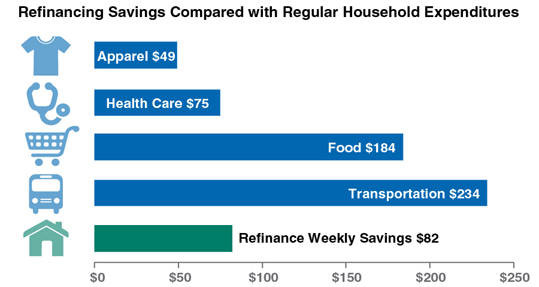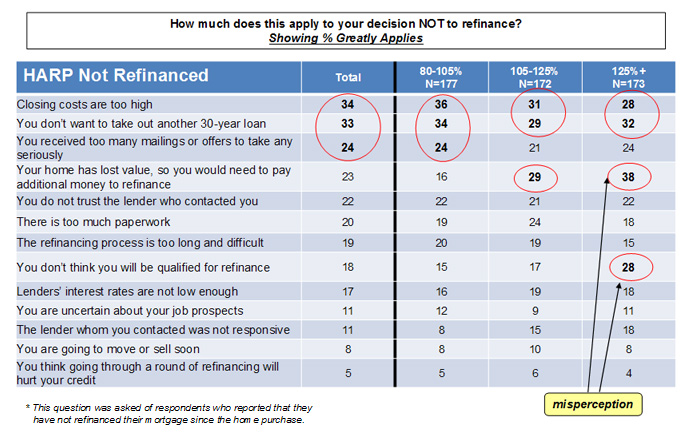What Motivates Underwater Borrowers to Refinance?

In June 2012, Fannie Mae's Economic and Strategic Research (ESR) team explored the benefits of refinancing for American households and the U.S. economy (see FM Commentary: Refinancing Helps Many Households Restore Their Financial Health). Between 2009 and November 2012, Fannie Mae refinanced more than 8.9 million mortgages, including nearly 1.2 million loans refinanced through the Home Affordable Refinance Program (HARP).1 HARP was created to help borrowers refinance despite having little or negative equity in their homes due to a decline in their home value. In late 2011, HARP guidelines were expanded to remove many of the barriers affecting borrowers who are current on their mortgage but are deeply underwater.
In the ESR piece cited above, Orawin Velz writes, "refinancing lowers their monthly mortgage payment, freeing up cash that can be used for other goods and services." To put this into context, borrowers who refinance through HARP have an average weekly savings of approximately $82.2 According to the Bureau of Labor Statistics, this savings would pay for the average household’s weekly clothing costs or about 50 percent of a household's weekly food consumption.3

Despite the potential financial benefit from refinancing, hundreds of thousands of potentially eligible underwater borrowers have yet to take advantage of the HARP program. This begs the question: why?
To understand underwater borrower motivations and potential barriers to refinancing, the ESR team conducted a survey of HARP-eligible borrowers who have loans held by Fannie Mae, as of July 2012. Among the 2,400 respondents, half of those surveyed have already refinanced through the HARP. The other half have not refinanced through HARP, but would meet the eligibility criteria to do so according to our estimation. For each refinanced and not-refinanced subpopulation, the sample is evenly distributed across three loan-to-value (LTV) categories: 80-105 percent, 105-125 percent, and 125+ percent.
The survey revealed the following findings:

Misperceptions and distrust hamper borrowers: Many HARP-eligible borrowers who have yet to refinance do not fully understand the program's terms. For example, 38 percent of deeply underwater borrowers (LTVs of 125 percent or greater) said that they would need to pay additional money to refinance because their home has lost value. Twenty-eight percent of deeply underwater borrowers also questioned whether they would qualify at all for a refinance.
Additionally, nearly a quarter of those who have yet to refinance said that they have “received too many mailings or offers to take any seriously.” Twenty-two percent of borrowers who have yet to refinance said that they “do not trust the lender that contacted [them].”
While borrowers are motivated by reducing their monthly payments, concerns about closing costs and extending terms are barriers to refinancing: Borrowers who have refinanced cite the ability to reduce monthly payments as the primary reason for refinancing. At the same time, those who have yet to refinance cite concerns regarding closing costs and the fact they do not want to take out another 30-year loan as the primary barriers to refinancing.
Borrowers look to mortgage servicers to inform their decision on refinancing:It is clear that a servicer is an important conduit of information and can play a meaningful role in a borrower’s decision-making process. The survey shows that borrowers who have refinanced are far more likely to have heard about HARP from their mortgage servicers than those that have not refinanced.
Over the past 12 months, partly due to expanding eligibility rules, we have witnessed a significant increase in HARP volumes. At the same time, many borrowers remain on the sidelines. Our National Housing Survey shows that about 55 percent of homeowners have refinanced the mortgage on their current homes. However, our survey of HARP-eligible borrowers indicates that there are potential barriers and misperceptions that may be overcome to encourage borrowers who have not yet refinanced to explore their options. Overcoming these barriers and misperceptions could benefit households. Importantly, for many borrowers who are currently eligible for refinancing, time may be running out – HARP is scheduled to expire at the end of 2013.
Tom Seidenstein
Vice President for Financial Markets and Policy Research
Economic & Strategic Research
March 6, 2013
Opinions, analyses, estimates, forecasts and other views of Fannie Mae's Economic & Strategic Research (ESR) group included in this commentary and related Housing Insights should not be construed as indicating Fannie Mae's business prospects or expected results, are based on a number of assumptions, and are subject to change without notice. How this information affects Fannie Mae will depend on many factors. Although the ESR group bases its opinions, analyses, estimates, forecasts and other views on information it considers reliable, it does not guarantee that the information provided in these materials is accurate, current or suitable for any particular purpose. Changes in the assumptions or the information underlying these views could produce materially different results. The analyses, opinions, estimates, forecasts and other views published by the ESR group represent the views of that group as of the date indicated and do not necessarily represent the views of Fannie Mae or its management.
The views expressed in these articles reflect the personal views of the authors, and do not necessarily reflect the views or policies of any other person, including Fannie Mae or its Conservator. Any figures or estimates included in an article are solely the responsibility of the author.
1 For the latest HARP volume details, please see “Refinance Report” published by Federal Housing Finance Agency, November 2012. https://www.fhfa.gov/webfiles/24967/Nov2012RefiReport.pdf
2 Economic & Strategic Research estimate: a weighed average, year-to-date through November 2012, of monthly savings based on 30-year fixed-rate mortgages converted to 30-year fixed-rate refinances, HARP only, across all LTVs, divided by four to get the weekly savings estimate.
3 Bureau of Labor Statistics, Consumer Expenditure Survey, 2011 data released in September 2012. https://www.bls.gov/cex/2011/Standard/cucomp.pdf. Estimates based on the annual average of four-person households (husband, wife, and two children), divided by 52 to get the weekly expenditure estimates.
4 The Fannie Mae National Housing Survey is a monthly survey that polls 1,000 adults every month across the U.S. with more than 100 questions to assess consumers’ attitudes regarding the economy, household finances, and owning and renting. For details, please see https://www.fanniemae.com/portal/research-and-analysis/housing-survey.html
